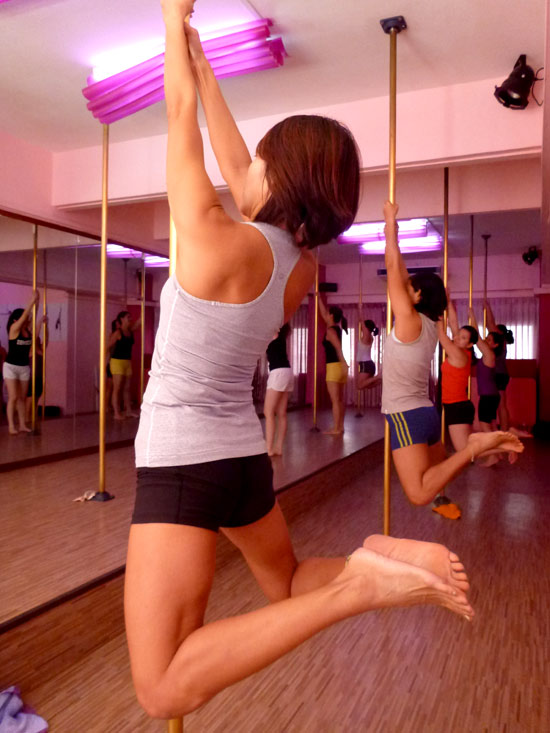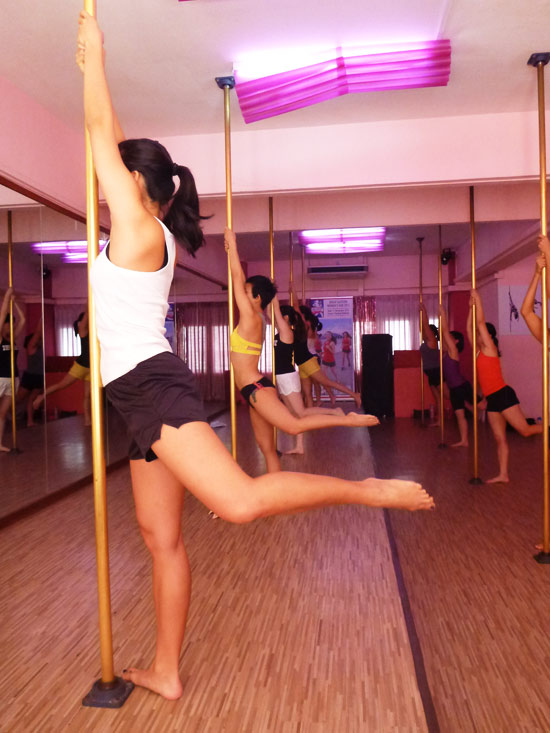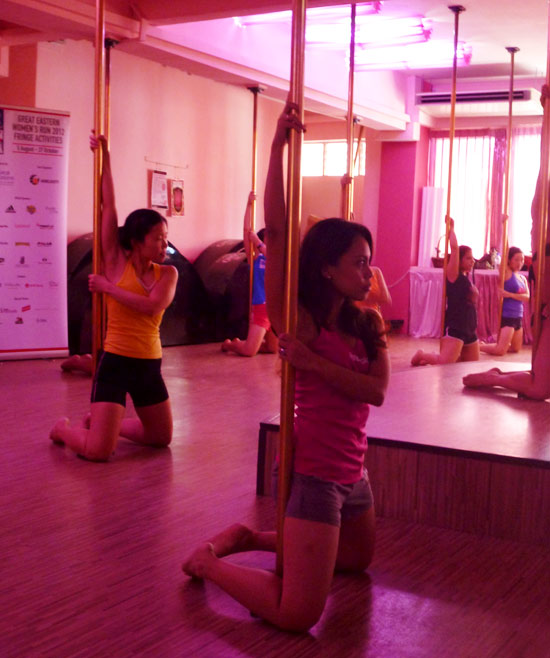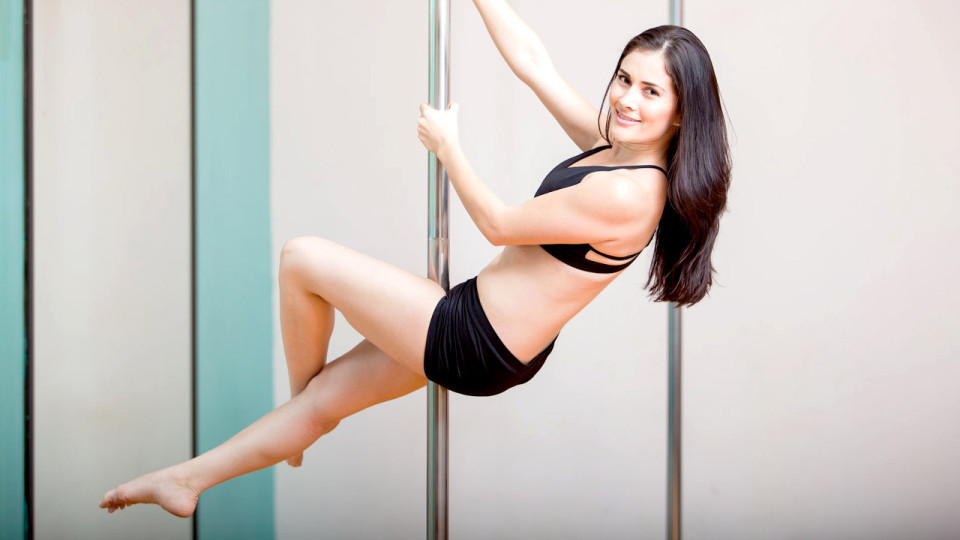In many forms of exercise, we tend to create generic goals, sometimes goals that may not be achievable. However, spending one and half hours at Bobbi’s Pole Studio, with a bunch of enthusiastic ladies and an inspiring instructor, showed that there is always a new move that is just within reach. No, the class did not guarantee you’ll get a six pack after one lesson, neither did it promise that you’ll do a fireman spin, but it has proven to target your entire body. It uses major and minor muscles, and more importantly the core muscle strength that is crucial for running.
A pole dance class typically involves some spins, climbs, dance moves and sometimes floor work as well. This combination of intensity levels classify pole dancing as an interval training, which is great for runners to try after running intensely. Interval training is known to be one of the best ways to burn fat and drastically improve your cardiovascular fitness. Pole dancing is indeed a fun and sexy way to get fit!
The number one rule: Stretch
A proper full body stretch was carried out to help improve flexibility and hence minimise injuries when pole dancing.
Clad in tank tops and shorts, participants were discouraged from applying moisturisers on hands and legs, as it will affect their grip on the pole.
A series of warm up stretches involving simple movements like head rotation, forward body and leg presses were led by the instructors. The participants also did some side lunges, and stretches with legs outstretched while sitting on the floor. What was unique was that the ladies were able to use the pole to aid in their stretches. As the participants held on to the pole, they used it to stabilise their bodies as they twisted and arched their bodies to feel the stretch. Throughout the stretching, we were reminded to sit up tall and to elongate our spines. Good body posture was emphasised during the warm-up.
Strength training is important for pole dancing
Pole dancing is mostly strength based training, so muscles will be used in different ways and in a different order.
As the music became more upbeat, the instructor took the participants through a series of body conditioning exercises such as planks, push-ups and crunches, the participants were also asked to execute side to side crunches with their legs crossed, as if their legs are holding on to the poles. The instructor also took the ladies through a series of cat stretches at the end of these exercises.

Next, the participants were asked to stand in front of the pole with both hands holding the pole. The instructor said we should train the elbows to stay close to the side of the ribcage, this is almost like the correct arm movements when running.
Getting accustomed to the pole for the first time
Before getting started, participants with sweaty palms were advised to put some antiperspirant powder/spray on their hands and to wipe the pole with a cloth to prevent slipping.
The instructor first instructed the participants to lift their right legs up and to hook their right leg to the pole, parallel to the ground, like a table top. After which they were told to pull their chest close to the pole and further lift their left and right leg away from the floor, towards the back wall. It is important for the participants to squeeze their butts and legs when attempting this move. This is a good way to engage the core and arm muscles as the participants are using these muscles to hold their natural body weight while on the pole.
Coordination and controlled movements
The key for pole dancing is in the coordination of your body movements. Your body must be coordinated and controlled the moment you grab the pole. The instructor further explained that controlled movement requires a good sense of balance and a good use of the core muscles.

Hanna, Bobbi’s Pole Studio’s instructor, explained
Pole dancing has two main components, which are core and flexibility, so with a stronger core you would have been able to maximize the use of energy. Some runners instead of just using just their legs, use a lot of their upper body and they move so much, but if you were to have a stronger core, you would be able to hold yourself stronger, and have a better running posture and as a result your energy would be mostly used on the running rather than using energy for unnecessary body movements. If you have better flexibility, you will have a wider range of motion. So relating to running, you’d be able to have wider strides, thus leading to efficiency in running. It is advisable that runners to stretch before running, this is very important.
Move #1: Knee Spin
Prior to teaching the participants how to execute a Knee Spin, participants were asked to test the tightness of their knee grip by holding their hands in-between their legs and squeezing the knees together. The instructor demonstrated a Knee Spin gracefully and effortlessly. An acid test to see if your knees are gripping the pole properly is to let go of your left hand while your knees are still gripping the pole and see if you will still hang on to the pole.
With so much coordination, major and minor muscles involved, everyone was pushed out of their comfort zone.
Move #2: Vanessa
The participants were taught to step forward with their left leg and wrap their right leg on the pole; they have to paddle forward towards the mirror with their knees apart and their feet together. All the while, making sure that their knees and feet are parallel to the floor.
The instructor also taught the participants how to dismount nicely (i.e. right foot touching the ground first, followed by left foot) so that the finishing looks effortless.
Move #3: Kate Moss
This move requires the ladies to step forward with their right leg, wrap their right toe with their left before spinning around. This is a fairly simple move and you may take this chance to ‘rest’ while executing this movement if tiredness sets in.
Move #4: Spin Climb
The last move that the instructor taught was called Spin Climb. Participants are to use their legs to pull and push themselves up the pole towards the ceiling. At this point, the instructor was walking around the room to correct the posture of the participants.
The key to pole dancing is flexibility and strong core muscles, these two components will help with right body alignment and a toned body.
Putting it all together
The participants were instructed to execute the moves that they had learnt in this sequence: Knee Spin – Vanessa – Spin Climb. The participants repeated this sequence twice to a tempo of an upbeat tune. The ladies were instantly rewarded when they saw themselves achieving the moves. Such a sweet taste of victory quickly becomes addictive.

At the end of the session, we were pleasantly greeted by two wonderful performances by our two beautiful instructors. They each gave a mind-blowing performance, enough to inspire many of us to want to pole dance. Should there have been a heat detector in the room, no doubt our inspiring instructors would have set off the alarm with their ‘siren-worthy’ performances.
At the end of the day, pole dancing is not simply a sensual and seemingly gravity defying feat; but very much about learning how to control one’s body movements in creating graceful lines and a show of inner and outer strength. These are valuable qualities which will aid greatly in our running!
Pole dancing is definitely not for the faint hearted. Kudos ladies for your courage and openness in trying something new!
In conjunction with the Great Eastern Women’s Run, there will be other activities coming up for runners to pick up. Check out the official website at www.greateasternwomensrun.com for more information.





